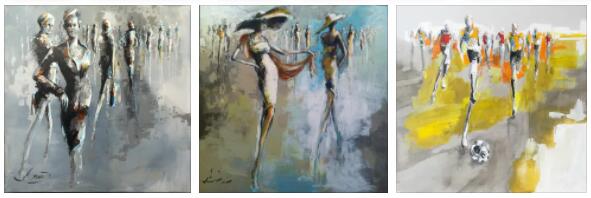
The Sixties marked a turning point in French artistic life: a progressive disaffection of young artists towards abstract art was manifested, which, on the other hand, corresponded to a growing interest in the figure.
According to Ethnicityology, this spontaneous return to figuration unites very divergent tendencies at the beginning of the 1960s.
On the one hand, we meet former traditional figurative painters such as P. Rebeyrolle (born in 1926) who had not ceased to represent, for the younger generations, the guide of a new figurative art, having among other things participated in the creation of the Salon de la June Peinture (1949) which, in controversy against abstractionism, played an important role in shaping the desire for a return to a realist and humanitarian art. there are also painters coming from abstraction, such as P. Alechinsky (born in 1927) or who still try to achieve the impossible synthesis of abstraction and figuration, such as R. Lapoujade with his Emeutes (1961). We then meet some older artists who were overshadowed by the vogue of abstraction, but who had continued to paint and exhibit, following their somewhat baroque and expressionistic figurative vein, in which color dominates, as in Lapique (born in 1898) or the movement, as in Pignon (born in 1905). Among these, it should be remembered that master of abstract art, then converted to figuration in 1939, which is J. Hélion (born in 1904), whose importance will be rediscovered towards the end of the 1960s, as evidenced by the numerous exhibitions and retrospectives that, in that period, were dedicated to him.
On the other hand, this new figuration, almost in fear of affirming itself as such and in an attempt to make itself better accepted in a context still dominated by abstraction, will disguise itself, for a time, under garments borrowed from the expressionist or fantastic tradition.. To this trend belong the hallucinatory figuration of a Lebenstein or a Maryan, the caricatures marked by the grimace of a Giromella, the landscapes populated by monsters by the Yugoslavian Dado (born in 1933), the humorous and biting collages of a Baj.
Very soon, however, partly under the influence of English and American Pop art, of which French artists are beginning to know the production, a need for objectivity emerges that will make us forget allusiveness and deformation in favor of a contemplation of reality in its brute presence. Thus, on the one hand, we have the breaking in of the object, the artifact elevated to the rank of a work of art; on the other hand, there is the development of an art of the subject and the anecdote.
The first current develops around the Nouveau Réalisme – as it was baptized by the critic P. Restany – whose first exhibition takes place in Paris in June 1960: it brings together a certain number of artists who claim to appropriate reality as it is. is, in its mocking immediacy. It is Arman (born in 1928) with his accumulations of objects of common use; of César (born in 1921), with his compressions, following the stage of venus; of Spoerri (born in 1930), who “traps) the leftovers of the meal, gluing the various elements on the surface of a table which he thus transforms into bas-relief; and finally of the affichistes, Heins (born in 1926), J. Villeglé (born in 1926), Dufrêne (born in 1930) and the Italian M. Rotella (born in 1918), who display tattered posters taken from walls and palisades. This same attraction towards the objects of the daily folklore of opulent society is found in a later generation, some representatives of which will sometimes be called the objecteurs. We can mention M. Raysse, with his bazaar articles assembled in such a way as to assume the dignity of a poetic environment, and JP Raynaud (born in 1939), with his “psycho-objects” which, with their icy and hygienic aspect, constitute an anticipation of hyper-realistic aesthetics and, again, A. Dufo (born in 1934) with his curious trompe-l’oeil paintings.
Quite close to this current – on a level that is no longer that of three-dimensional assemblage, but that of the flat image – are the representatives of Mec art or mechanical art, who use, as before them, the Americans Rauschenberg and Warhol, the photographic transfer on canvas and the photomechanical impression procedures. This is the case, for example, of A. Jacquet (born in 1939) whose most famous work remains the elaboration of one of the most famous classic of pictorial realism, The swimming pool by T. Eakins.
The second current – the one aimed at the anecdote, the story, the narration, the chronicle – takes the name of “narrative figuration”, a name assigned to it by the critic G. Gassiot-Talabot who, in July 1964, brought together some of his representatives in an exhibition entitled “Daily Mythology”. What this initiative of his brought out was, with the loss of an aesthetic of expressiveness, the affirmation of an aesthetic of the document; it was, in contrast to the subjective and passionate beauty of abstractionism, the birth of an icily objective beauty. Painting, again, began to tell, and to tell the everyday, with narrative procedures borrowed, more often than not, from comics, as can be seen, for that period, in artists such as B. Rancillac (born in 1931).